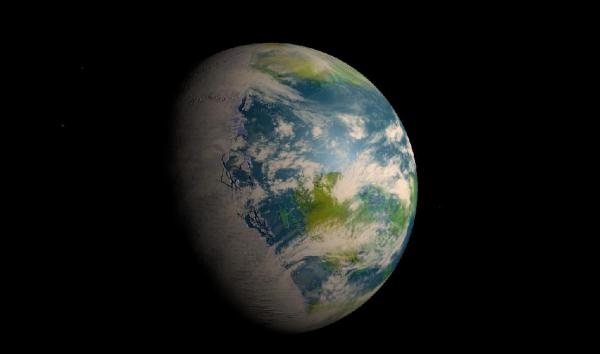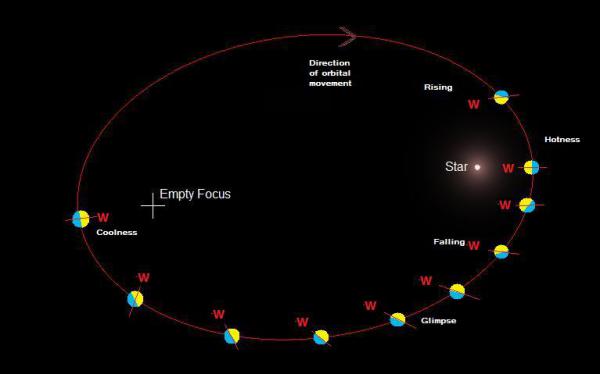BY LETTER
Locus
Galactography > Regions of Space > Middle Regions/Hinter-regions
Galactography > Sephirotic Empires > Non-Coercive Zone (NoCoZo)
Galactography > Systems and Worlds > Systems & Worlds K - L
Galactography > Sephirotic Empires > Non-Coercive Zone (NoCoZo)
Galactography > Systems and Worlds > Systems & Worlds K - L
Eccentric Tidally-locked World | |
 Image from Steve Bowers | |
| As Locus slowly turns its icy hemisphere towards the sun during the season known as Rising, the sea-ice breaks up in mid-ocean | |
Star
Name: JD 9044191
Type: K9 orange dwarf
Luminosity: 0.0783 x Sol
Distance from Sol: 2221 ly
Constellation: Cancer
Planet
Name: Locus
Type: Ikarian/Vesperian terrestrial (Eccentric tidally locked world)
Semi-major axis: 0.27 AU
Eccentricity: 0.73
Year length: 0.2 standard years (74 days)
Diameter: 10081 km
 Image from Steve Bowers | |
| Locus keeps the same hemisphere oriented permanently more-or-less directly towards the empty focus in its orbit. The so-called 'Warm Pole' (shown as W in this diagram) is directly beneath the local sun when the planet is at apastron and periastron; but at all other times it is pointed at varying angles to the sun, causing variable climate patterns at different times of the short year | |
Reached in 6207 AT by the Jardine Venture, an independent exploration corp formerly affiliated to the NoCoZo, this planet had already been the subject of long-distance study for some time. A rare example of a highly eccentric terrestrial world which was also tidally-locked, the world that became known as Locus has a very strange day-night cycle. The planet does not permanently face the star, instead it faces in the general direction of the empty focus of its orbital ellipse. This means that there is no permanent darkside, and even the antisunward point of the planet (which faces away from the star at periastron) briefly gets some sunlight when the planet is between the foci.
The point which is beneath the star at periastron and at apastron is known as the Warm Pole. However for a considerable fraction of the planet's orbit the Warm Pole is pointed up to 90 degrees away from the local star, and at those times the warmest part of the planet is roughly half-way between the Warm Pole and the so-called Cold Pole. Briefly the Cold Pole receives some direct sunlight, both because the local sun is slightly above the horizon and because of refraction.
The seasons on Locus vary very much according to where on the planet an observer is located; the various climate regimes are known as local seasons, or Loci, and the whole planet (originally called JD 9044191b) was renamed Locus when terraformed.
The whole year lasts 74 standard days; the Warm Pole is close to the star and faces directly towards it for a few standard days during the season called Hotness, and at apastron the Warm Pole faces the star again for several days in the season called Coolness. The heat from the local star is so intense during the Hotness season that (before terraforming) all surface water in that hemisphere reached boiling temperatures, and to reduce this to habitable temperatures the upper atmosphere of Locus has been modified extensively. A swarm of tiny balloon-like drones known commonly as 'weather machines' reflect most of the sunlight back into space during the Hotness season, and reverse the action in cooler seasons to retain heat.
In between the two hemispheres experience long periods where they point towards the local star. The eastern hemisphere experiences a warmer period first, which diminishes as the planet moves away from the star (this is called Falling) and the western hemisphere experiences a slowly increasing heat, known as Rising. Rising and Falling both last twenty days; during Rising the eastern hemisphere is largely in darkness, so experiences a bitter winter, and during Falling the west is darkened and cold.
The short period when the local Sun is visible at the Cold Pole is known as Glimpse. Of course the severity of these seasons is reduced by the active layer of weather machine dronelets.
A single cryojovian planet orbits more than 40 AU from the star, shepherding an asymmetric Kuiper Belt which is sparse and supports a small population of Backgrounders.
The Early Colony
By 6800 the former anoxic atmosphere (mainly nitrogen and argon, with some CO2) was modified to contain enough oxygen for a population of mildly tweaked nearbaseline humans. The degree of control over the climate afforded by the weather machines is helped by relatively atmospheric density which assists the transfer of warmth from the sunlit hemisphere to the shadowed regions. However the variation between the seasons on this world are still very apparent. Tailored vegetation covers the continents, especially the somewhat cooler mountain regions in the Eastern Hemisphere.At first the various Loci and their very different climate conditions were home to many separate local nation-states which had little in common. Caliente in the Warm Pole region was a successful city-state, and the buried cities at the Cold Pole were isolated and independent, though never very populous. But the world of Locus gradually became more dependent of sophisticated communications and information technology, and the actual physical location of each citizen became less important to their cultural lifestyle than their worldwide cultural connections.
Panarchy
During the Central Alliance era the concept of nation-states on Locus became redundant, but instead of being replaced by a single world-wide state or a nationless culture, a version of the political system known as Panarchy was adopted on this world. Innumerable small special-interest micronations were established which were not associated with specific locations (or indeed Loci) on the surface of the world; instead they existed as abstract legal entities each considered to be truly sovereign and independent nations, which could have possession of parcels of land or infrastructure, quite often virtual, but just as often did not.Each citizen on Locus had the right to join, leave or establish any such micronation at any time, and competition between these micronations kept the political and economical systems of Locus in a state of constant renewal. Membership of a micronation was sometimes like being part of a club, and sometimes like being part of a religious sect, or a family, and the fraternity involved in such a membership was a very important factor in their popularity. The smallest possible micronation was a single person, and for a while it became fashionable for transapient individuals to become micronations on this world,but they tended to be either too successful or too disruptive and after much debate the Locus United Micronation Assembly decided in 8777 to restrict their membership to modosophonts.
For more than a millennium after that date the panarchy of Locus became increasingly dominated by commercial and corporate microstates, with many states becoming subject to leveraged buyouts and aggressive takeovers. In many ways the old panarchic system was developing to be more like some other worlds in the NoCoZo, where commercial entities of many kinds have largely or wholly superseded nationstates.
In 10022 the Assembly decided to readmit transapient individuals as micronations or members of micronations; paradoxically this has led to a resurgence in the older ways, where the fraternity between members could seem as important as the economic success of the statelet, sometimes more so. Some commentators suggest this is due to nostalgic sentiment felt by the transapients who are increasingly involved in the affairs of this world, while others suggest it is more complex than that.
Panarchy of various kinds has emerged as a political system on many worlds in the Terragen Sphere, but as it is a very localised and decentralised form of government, it rarely becomes expansive or imperialistic.
Related Articles
- Ikarian type world
- Political Science - Text by M. Alan Kazlev
The branch of the social sciences concerned with the description and analysis of polities, government, politics, and political institutions and processes. Fields of study include political parties and ideology, types of government, administration, regulation, statecraft, foreign policy, war, civil rights, political thought, constitutions, historical politics (specializing in a particular polity or era), comparative politics, xenopolitics, the relation between people and government, or between lower toposophic citizens and higher toposophic sovereigns. - Vesperian Type Worlds
- Weather Machines
Appears in Topics
Development Notes
Text by Steve Bowers
Initially published on 08 November 2011.
Initially published on 08 November 2011.






